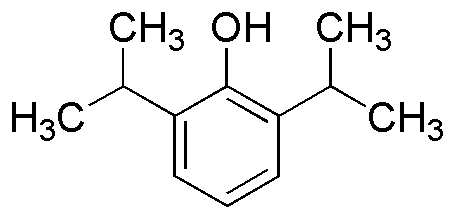2,6-Diisopropylphenol is widely utilized in research focused on:
- Antioxidant Applications: This compound serves as an effective antioxidant in various formulations, helping to prevent oxidative damage in products such as cosmetics and food preservatives.
- Industrial Lubricants: It is used in the formulation of high-performance lubricants, enhancing the stability and performance of oils under extreme conditions, making it valuable in automotive and machinery industries.
- Pharmaceutical Intermediates: The compound acts as an intermediate in the synthesis of pharmaceuticals, contributing to the development of drugs with improved efficacy and reduced side effects.
- Polymer Additives: It is incorporated into polymers to improve thermal stability and resistance to degradation, which is crucial in the production of durable plastics and coatings.
- Research in Chemical Synthesis: Researchers utilize this compound in various chemical reactions, exploring its unique properties to develop new materials and compounds with specific functionalities.
Información general
Propiedades
Seguridad y normativas
Aplicaciones
2,6-Diisopropylphenol is widely utilized in research focused on:
- Antioxidant Applications: This compound serves as an effective antioxidant in various formulations, helping to prevent oxidative damage in products such as cosmetics and food preservatives.
- Industrial Lubricants: It is used in the formulation of high-performance lubricants, enhancing the stability and performance of oils under extreme conditions, making it valuable in automotive and machinery industries.
- Pharmaceutical Intermediates: The compound acts as an intermediate in the synthesis of pharmaceuticals, contributing to the development of drugs with improved efficacy and reduced side effects.
- Polymer Additives: It is incorporated into polymers to improve thermal stability and resistance to degradation, which is crucial in the production of durable plastics and coatings.
- Research in Chemical Synthesis: Researchers utilize this compound in various chemical reactions, exploring its unique properties to develop new materials and compounds with specific functionalities.
Documentos
Hojas de datos de seguridad (HDS)
La SDS proporciona información de seguridad completa sobre la manipulación, el almacenamiento y la eliminación del producto.
Especificación del producto (PS)
La PS proporciona un desglose completo de las propiedades del producto, incluida la composición química, el estado físico, la pureza y los requisitos de almacenamiento. También detalla los rangos de calidad aceptables y las aplicaciones previstas del producto.
Certificados de análisis (COA)
Busque certificados de análisis (COA) ingresando el número de lote del producto. Los números de lote y de partida se pueden encontrar en la etiqueta de un producto después de las palabras "Lote" o "Lote".
Número de catálogo
Número de lote/lote
Certificados de origen (COO)
Este certificado de origen confirma el país en el que se fabricó el producto y también detalla los materiales y componentes utilizados en él y si se deriva de fuentes naturales, sintéticas u otras fuentes específicas. Este certificado puede ser necesario para cumplir con las normativas aduaneras, comerciales y regulatorias.
Número de catálogo
Número de lote/lote
Hojas de datos de seguridad (HDS)
La SDS proporciona información de seguridad completa sobre la manipulación, el almacenamiento y la eliminación del producto.
DownloadEspecificación del producto (PS)
La PS proporciona un desglose completo de las propiedades del producto, incluida la composición química, el estado físico, la pureza y los requisitos de almacenamiento. También detalla los rangos de calidad aceptables y las aplicaciones previstas del producto.
DownloadCertificados de análisis (COA)
Busque certificados de análisis (COA) ingresando el número de lote del producto. Los números de lote y de partida se pueden encontrar en la etiqueta de un producto después de las palabras "Lote" o "Lote".
Número de catálogo
Número de lote/lote
Certificados de origen (COO)
Este certificado de origen confirma el país en el que se fabricó el producto y también detalla los materiales y componentes utilizados en él y si se deriva de fuentes naturales, sintéticas u otras fuentes específicas. Este certificado puede ser necesario para cumplir con las normativas aduaneras, comerciales y regulatorias.


